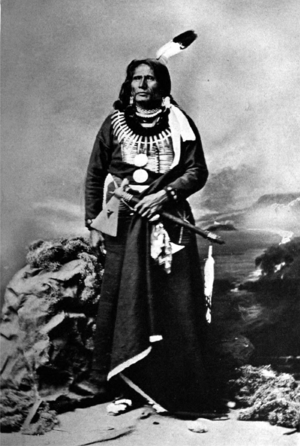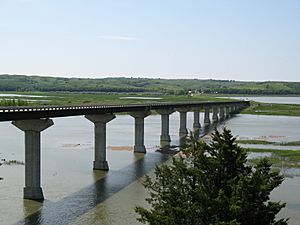Standing Bear facts for kids
Standing Bear (born around 1829, died 1908) was a leader of the Ponca people. His Ponca name was Maⁿchú-Naⁿzhíⁿ. He became famous for fighting for the rights of Native Americans.
In 1879, Standing Bear won a very important court case in Omaha, Nebraska. The court decided that Native Americans are "persons within the meaning of the law." This meant they had the right to habeas corpus. This was the first time a Native American was given civil rights by a court in the United States. His first wife, Zazette Primeau, was also part of the legal action.
Contents
Standing Bear: A Fight for Rights
Early Life of the Ponca People
By 1789, the Ponca people lived in villages along the Niobrara River. They also lived as far east as what is now Ponca, Nebraska. A terrible smallpox sickness in the early 1800s greatly reduced their numbers.
When Standing Bear was born around 1829, the Ponca grew corn, vegetables, and fruit in the summer. In winter, they traveled west to hunt bison. During these hunts, they often met their enemies, the Brulé and Oglala Lakota. Sometimes, the Ponca even joined their enemies to raid Pawnee and Omaha villages.
Changes and Challenges for the Ponca
As Standing Bear grew up, raids from the Brulé forced the Ponca to rely more on farming. They hunted less bison. The tribe later split into two villages. Standing Bear learned how to hunt and fish, preparing to be a leader.
In 1859, many European-American settlers moved into the area. The U.S. government wanted the Nebraska tribes to sell their land. The Ponca also faced raids from the Brulé and Oglala from the north.
By 1862, white settlers were building the town of Niobrara, Nebraska. This was where the Ponca used to grow corn. Raids from the north stopped the Ponca from reaching their winter hunting grounds. This forced them to leave one of their villages. In 1858, the Ponca gave up much of their land to the United States. They kept a smaller area between Ponca Creek and the Niobrara River.
The new land was not good for farming. This led to constant famine (lack of food). They were also still attacked by other tribes. The government did not keep its promises from the 1858 treaty. It failed to provide mills, staff, schools, or protection. Many Ponca suffered from sickness and starvation.
In 1865, a new treaty allowed the Ponca to return to their traditional farming and burial grounds. This land was more fertile and safer. However, in 1868, the government illegally gave this new Ponca land to the Santee Dakota. This was part of a deal to end Red Cloud's War. Soon, the government tried to move the Ponca to Indian Territory.
Forced Move to Indian Territory
In 1877, Ponca leaders, including Standing Bear, met with a U.S. Indian Agent. They signed a paper that seemed to allow them to move to Indian Territory (now Oklahoma). But the Ponca leaders later said it was a mistake. They thought they were moving to the Omaha Reservation, not far away to Indian Territory.
In February 1877, ten Ponca chiefs, including Standing Bear, went to Indian Territory to see new lands. They did not like the lands they saw. They asked to go home. But an angry government inspector refused. Eight of the chiefs decided to walk home. The inspector chose the Quapaw Reservation for the Ponca. In April, some Ponca moved there. In May, the rest of the tribe, including Standing Bear and his family, were forced to move.
The Ponca arrived in Oklahoma too late to plant crops that year. The government also did not give them the farming tools it had promised. In 1878, they moved again, about 150 miles west. By spring, almost a third of the tribe had died. Many got sick and died from hunger and disease. Standing Bear's oldest son, Bear Shield, was one of them. Standing Bear had promised to bury his son in their homeland in the Niobrara River valley. So, he left with about 30 followers to travel north.
When they reached the Omaha Reservation in Nebraska, their relatives welcomed them. But the government soon found out. The Secretary of the Interior ordered General George Crook to arrest the Ponca. They were arrested for leaving the reservation. Standing Bear and the others were taken to Fort Omaha. General Crook felt sorry for the Ponca. He was shocked by the terrible conditions they had left. He delayed their return so they could rest and get legal help.
General Crook told the Ponca's story to Thomas Tibbles. Tibbles was a strong supporter of Native American rights. He was an editor for the Omaha Daily Herald. Tibbles shared the Ponca's story widely. Two lawyers, John L. Webster and Andrew J. Poppleton, offered to help for free.
They helped Standing Bear. In April 1879, he filed a lawsuit for a writ of habeas corpus in a U.S. District Court in Omaha, Nebraska. Susette La Flesche, a smart and educated Omaha woman, translated for Standing Bear. The case was called United States ex rel. Standing Bear v. Crook. General Crook was named in the case because he was holding the Ponca.
What is Habeas Corpus?
Habeas corpus is a legal term. It means that a person who is arrested has the right to be brought before a judge. The judge then decides if their arrest and imprisonment are legal. It protects people from being held without a good reason.
Standing Bear's Powerful Speech
As the trial was ending, the judge allowed Chief Standing Bear to speak for himself. He raised his right hand and spoke. He said, "That hand is not the color of yours, but if I prick it, the blood will flow, and I shall feel pain. The blood is of the same color as yours. God made me, and I am a Man."
On May 12, 1879, Judge Elmer Scipio Dundy made his decision. He ruled that "an Indian is a person" under the law. This meant they had the right to habeas corpus. He said the government had no legal reason to arrest and hold the Ponca.
This was a very important case. It recognized that Native Americans are "persons" under the law. This meant they deserved its rights and protection. The judge said that the right to leave one's country is a natural right for everyone, including Native Americans.
After the ruling, the army immediately freed Standing Bear and his followers. The case got the attention of President Rutherford B. Hayes. He allowed Standing Bear and some of his tribe to return permanently to the Niobrara River valley in Nebraska.
Speaking Up for Native American Rights
Between 1879 and 1883, Standing Bear traveled around the eastern United States and Europe. He spoke about Native American rights. He was helped by people who supported Native Americans, like Wendell Phillips. Susette La Flesche and her brother Francis La Flesche traveled with him. They took turns translating his speeches. During his tour, Standing Bear gained the support of famous people like poet Henry Wadsworth Longfellow.
Standing Bear's Later Years
After his travels, Standing Bear lived in his old home on the Niobrara River. He farmed there with about 170 other Ponca who had been allowed to return.
In 1893, Standing Bear worked for Buffalo Bill's Wild West show in Chicago. He visited the World's Columbian Exposition (a big fair). He even rode the Ferris Wheel while wearing his full ceremonial headdress.
Standing Bear died in 1908 from oral cancer. He was buried on a hill overlooking where he was born. Today, the U.S. government recognizes two Ponca tribes: the Ponca Tribe of Nebraska and the Ponca Tribe of Oklahoma.
Standing Bear's Legacy and Honors
Standing Bear is remembered for his courage and his fight for justice.
- He was chosen for the Nebraska Hall of Fame.
- Ponca State Park in Nebraska is named after his tribe.
- In 1977, Standing Bear Lake opened.
- In 1998, the Chief Standing Bear Memorial Bridge was named in his honor. It crosses the Missouri River.
- In 1994, six tribes in Oklahoma started the Standing Bear Foundation. They hold an annual pow-wow to bring tribes and non-Native people together.
- In 2005, a new elementary school in Omaha was named after him.
- The 63-acre Standing Bear Park in Ponca City, Oklahoma is named for him. It has a museum and a 22-foot tall bronze statue of the chief.
- In 2017, a bronze sculpture of Standing Bear was placed in downtown Lincoln, Nebraska.
- In Lincoln, Nebraska, there is a city park called "Standing Bear Grounds."
- In 2019, a statue of Standing Bear replaced another statue in the Statuary Hall of the United States Capitol.
- Lincoln Public Schools began building Standing Bear High School in 2021, set to open in 2023.




